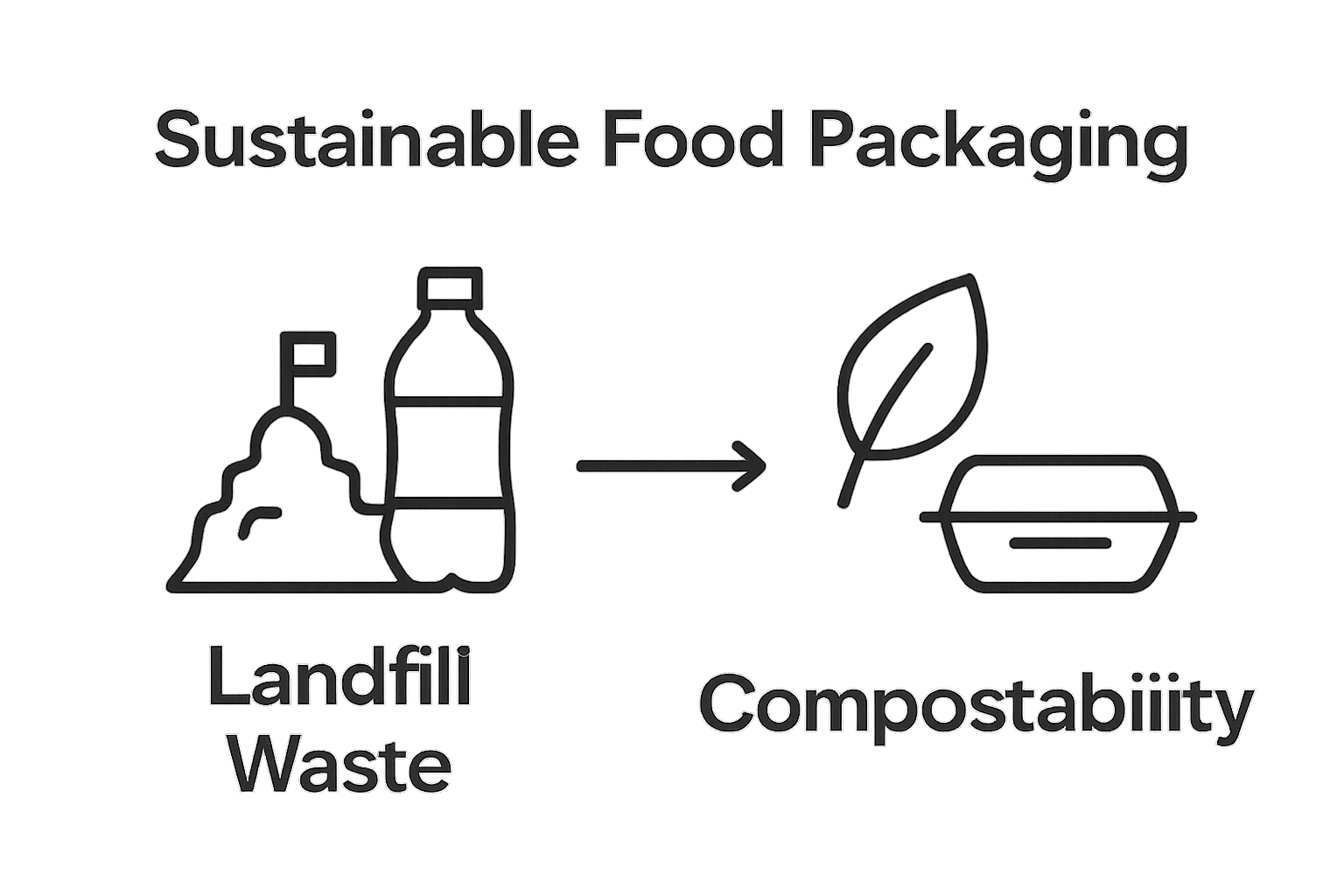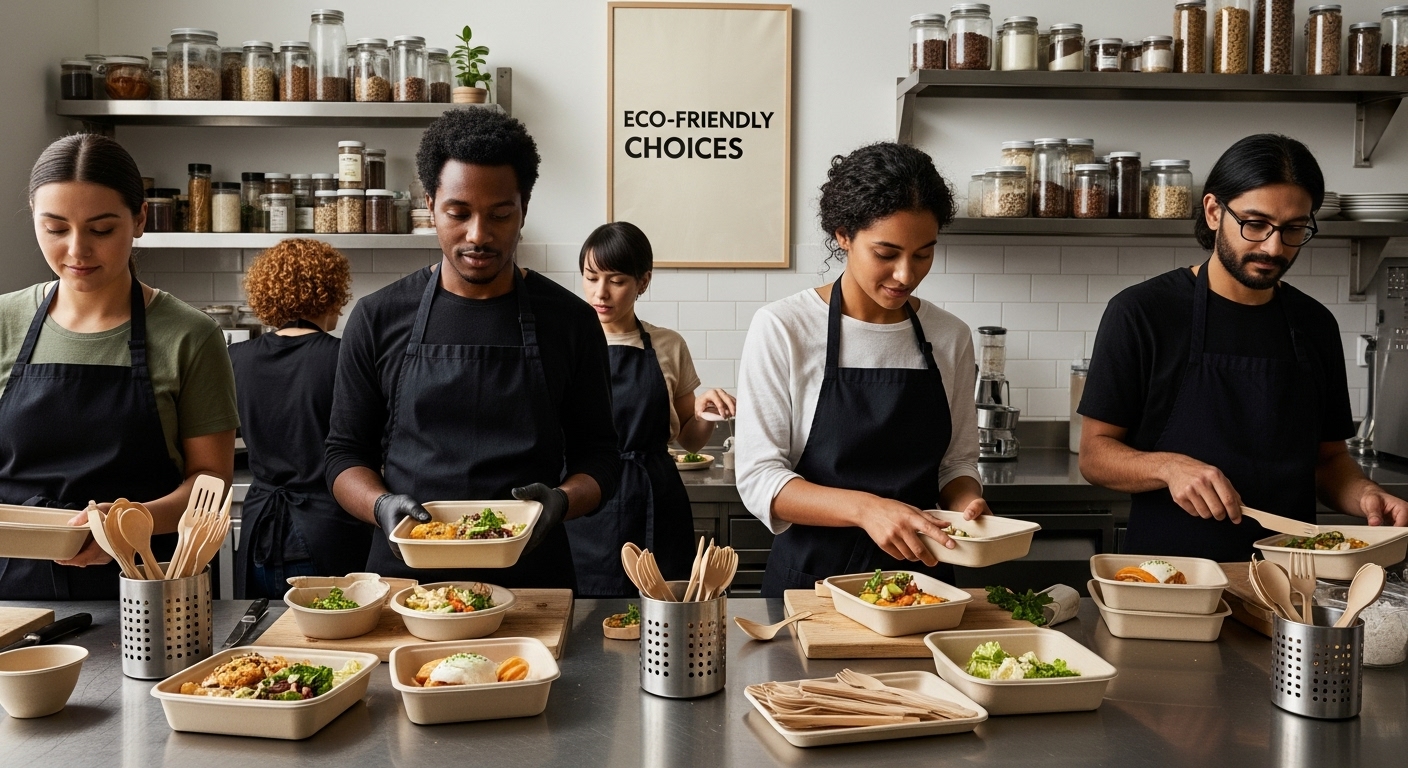L'emballage alimentaire durable redéfinit nos attentes vis-à-vis des produits qui entrent en contact avec nos aliments. Si l'image de montagnes de plastique et de déchets s'accumule encore est encore très répandue, plus de 380 millions de tonnes de plastique sont produites chaque année dans le monde, avec des conséquences environnementales désastreuses . Ce chiffre peut paraître alarmant, et pourtant, certaines entreprises transforment déjà les déchets agricoles en emballages entièrement compostables et rendent possibles les emballages comestibles. Le plus ingénieux ? Ces emballages peuvent être à la fois écologiques et pratiques, brisant ainsi l'idée reçue selon laquelle les solutions vertes sont forcément encombrantes ou coûteuses.
Table des matières
- Qu’est-ce que la durabilité dans l’emballage alimentaire ?
- Pourquoi la durabilité est importante pour l'emballage alimentaire
- Concepts clés des solutions d'emballage durables
- Comment fonctionne concrètement l'emballage durable
- Exemples concrets d'emballages alimentaires durables
Résumé rapide
| Emporter | Explication |
|---|---|
| Réduire l'utilisation des matériaux | Réduire les matériaux d'emballage sans compromettre la protection des produits alimentaires. |
| Utiliser les ressources renouvelables | Choisissez des matériaux d'emballage issus de sources durables et renouvelables afin de réduire l'impact environnemental. |
| Améliorer la recyclabilité | Concevoir des emballages faciles à recycler ou à composter, favorisant ainsi une économie circulaire. |
| Adopter les bioplastiques et les innovations | Mettre en œuvre des solutions d'emballage à base de plantes qui se décomposent naturellement et remplacent les matériaux nocifs. |
| L'accent est mis sur l'analyse du cycle de vie | Il convient de prendre en compte l'ensemble du cycle de vie des emballages afin d'optimiser l'efficacité et de minimiser les déchets de production. |
Qu’est-ce que la durabilité dans l’emballage alimentaire ?
L’emballage alimentaire durable représente une approche globale de la conception, de la production et de la gestion des solutions d’emballage qui minimisent l’impact environnemental tout en préservant la qualité et la sécurité des produits. Ce concept dépasse les méthodes d’emballage traditionnelles en intégrant des considérations écologiques, l’utilisation rationnelle des ressources et une responsabilité environnementale à long terme.
Les principes fondamentaux de l'emballage durable
L’emballage alimentaire durable repose sur plusieurs principes fondamentaux qui transforment notre façon d’envisager la protection et la présentation des produits alimentaires. Selon une étude publiée dans Environmental Science and Pollution Research , ces principes sont les suivants :
- Réduction de l'utilisation des matériaux : Diminuer le volume total des matériaux d'emballage sans compromettre la protection du produit
- Utilisation des ressources renouvelables : Sélection de matériaux issus de sources durables et régénératrices
- Améliorer la recyclabilité : Concevoir des emballages facilement recyclables ou compostables
Implications environnementales et économiques
L'approche du développement durable dans le domaine des emballages alimentaires va bien au-delà de la simple protection de l'environnement. Elle représente une méthodologie stratégique qui s'attaque à de multiples défis interdépendants. En repensant la conception des emballages, les entreprises peuvent simultanément réduire leur empreinte carbone, diminuer leurs coûts de production et répondre aux attentes toujours plus exigeantes des consommateurs.
Les entreprises reconnaissent désormais que l'emballage durable n'est pas seulement un choix éthique, mais aussi un atout concurrentiel. Consultez notre guide sur les idées d'emballage durable pour comprendre comment un design innovant peut transformer votre stratégie d'emballage.
Les principaux éléments transformateurs comprennent la sélection de matériaux à faible impact environnemental, l'optimisation des dimensions des emballages pour réduire les déchets et la mise en œuvre des principes de l'économie circulaire qui privilégient la réutilisation et la régénération des matériaux.
Pour donner un aperçu rapide des principaux enjeux environnementaux abordés, le tableau suivant résume les principaux défis environnementaux posés par les emballages alimentaires traditionnels et leurs principales conséquences.
| Défi environnemental | Description | Conséquence principale |
|---|---|---|
| Pollution plastique | Plus de 380 millions de tonnes de plastique sont produites chaque année. | De grandes quantités finissent dans les décharges et les océans. |
| Émissions de carbone | La fabrication de matériaux traditionnels produit des gaz à effet de serre | Augmentation des niveaux de gaz à effet de serre atmosphériques |
| Épuisement des ressources | Utilisation de matières vierges pour l'emballage | Consommation accélérée des ressources naturelles |
Pourquoi la durabilité est importante pour l'emballage alimentaire
L’emballage alimentaire durable dépasse le simple idéal environnemental ; il constitue une réponse essentielle aux défis mondiaux urgents qui touchent les entreprises, les consommateurs et la planète. Face à l’intensification des pressions environnementales mondiales, l’industrie de l’emballage alimentaire se trouve à la croisée cruciale de la responsabilité écologique et de l’innovation économique.
Impact environnemental et conservation des ressources
Les enjeux environnementaux liés aux emballages alimentaires sont considérables. Selon l'Organisation des Nations Unies pour l'alimentation et l'agriculture (FAO) , les emballages traditionnels contribuent de manière significative aux flux mondiaux de déchets, avec d'énormes conséquences écologiques. Parmi les principaux défis environnementaux, on peut citer :

- Pollution plastique : Plus de 380 millions de tonnes de plastique sont produites chaque année, dont des quantités importantes finissent dans les décharges et les océans.
- Émissions de carbone : La fabrication des matériaux d'emballage traditionnels génère d'importantes émissions de gaz à effet de serre.
- Épuisement des ressources : La dépendance continue aux matières premières vierges accélère la consommation des ressources naturelles
Perspectives économiques et de consommation
Au-delà des préoccupations environnementales, le développement durable est devenu un puissant levier économique et marketing. Les consommateurs fondent de plus en plus leurs décisions d'achat sur l'engagement environnemental des marques. Découvrez nos solutions d'emballage écologiques et comprenez comment le développement durable peut créer de la valeur pour votre entreprise.
Les entreprises qui adoptent proactivement des pratiques d'emballage durables bénéficient d'avantages concurrentiels grâce à la réduction des coûts des matériaux, à l'amélioration de leur image de marque et à une meilleure adéquation avec l'évolution des préférences des consommateurs. Ces derniers ne se contentent plus de vouloir des produits consommables ; ils recherchent des produits issus de pratiques de production et d'emballage responsables.
Le passage à des emballages alimentaires durables représente plus qu'une simple tendance environnementale : c'est une refonte fondamentale de notre approche en matière de protection des produits, d'utilisation des ressources et de responsabilité des entreprises au XXIe siècle.
Concepts clés des solutions d'emballage durables
Les solutions d'emballage durables représentent une convergence sophistiquée entre innovation scientifique, responsabilité environnementale et conception stratégique. Ces solutions dépassent les approches d'emballage traditionnelles en intégrant la science des matériaux de pointe, les principes de l'économie circulaire et des analyses de cycle de vie complètes.
Biomatériaux et technologies d'emballage alternatives
Les biomatériaux innovants révolutionnent les stratégies d'emballage durable. Selon une étude de la Bibliothèque nationale de l'agriculture , des scientifiques développent des solutions d'emballage novatrices à partir de sources de biomasse renouvelables. Parmi les innovations clés :
- Matériaux biopolymères : Extraction de cellulose et de protéines à partir de résidus agricoles pour créer des emballages biodégradables
- Intégration antimicrobienne naturelle : incorporation de composés biologiques protecteurs directement dans les matériaux d'emballage
- Transformation des déchets agricoles : convertir les résidus de récolte en composants d'emballage fonctionnels
Conception circulaire et efficacité des matériaux
Les principes de l'économie circulaire représentent une refonte fondamentale de la production d'emballages. Cette approche met l'accent sur l'optimisation des matériaux , les procédés régénératifs et la réduction des déchets . Apprenez-en davantage sur la réduction des déchets d'emballage pour comprendre les stratégies globales que les entreprises peuvent mettre en œuvre.
Les entreprises adoptent de plus en plus des approches holistiques qui prennent en compte l'intégralité du cycle de vie des matériaux d'emballage. Cela implique de concevoir des produits facilement recyclables, réutilisables ou biodégradables, minimisant ainsi l'impact environnemental et créant de la valeur économique grâce à la récupération et à la régénération des matériaux.
L'avenir des emballages durables repose sur l'innovation continue, la collaboration interdisciplinaire et un engagement à repenser la manière dont nous protégeons, transportons et présentons les produits alimentaires tout en préservant leur intégrité écologique.
Ce tableau présente et explique brièvement les principaux types de biomatériaux et de technologies innovants actuellement utilisés dans les emballages alimentaires durables, tirés des avancées scientifiques mises en avant dans l'article.
| Innovation en matière d'emballage | Source ou composition | Avantages en matière de durabilité |
|---|---|---|
| Matériaux biopolymères | Cellulose, protéines issues de résidus agricoles | Biodégradable et issu de sources renouvelables |
| Intégration antimicrobienne naturelle | Composés bioprotecteurs | Augmente la durée de conservation et réduit l'utilisation de produits chimiques |
| Transformation des déchets agricoles | Résidus de récolte | Recycle les déchets en composants d'emballage utiles |
| Bioplastiques à base d'acide polylactique (PLA) | À base de plantes (par exemple, amidon de maïs) | Entièrement biodégradable, remplace les plastiques dérivés du pétrole |
Comment fonctionne concrètement l'emballage durable
L’emballage durable transforme les principes environnementaux théoriques en solutions concrètes et pratiques qui répondent aux défis complexes liés à la conservation, au transport et à la présentation des aliments. La mise en œuvre de ces stratégies exige une approche globale qui concilie innovation technologique, responsabilité environnementale et viabilité économique.
Stratégies de sélection des matériaux et de conception
D'après une étude publiée dans Green Chemistry , les emballages durables reposent sur une sélection stratégique des matériaux prenant en compte de multiples critères de performance. Les principaux éléments à considérer sont les suivants :
- Composants biodégradables : Utilisation de matériaux tels que les lipides, les protéines et les dérivés de déchets agricoles
- Revêtements fonctionnels : Développement de couches protectrices qui améliorent la conservation des aliments tout en préservant la compatibilité environnementale
- Conception multifonctionnelle : créer des emballages qui répondent simultanément à des objectifs de protection, de marketing et d’écologie.
Performance du cycle de vie et intégration environnementale
Un emballage durable et pratique ne se limite pas au choix des matériaux ; il englobe l’ensemble du cycle de vie du produit. Consultez notre guide complet sur la réduction des déchets d’emballage pour comprendre l’approche globale nécessaire.
Les entreprises développent des solutions d'emballage qui contribuent activement à la préservation de l'environnement. Il s'agit de concevoir des produits facilement recyclables, biodégradables ou réutilisables sans générer de déchets importants. L'objectif est de créer des emballages qui remplissent leur fonction première de protection des aliments tout en minimisant l'impact écologique.
L'avenir des emballages durables réside dans la transformation continue des modèles d'emballage linéaires traditionnels en systèmes circulaires et régénératifs qui respectent à la fois les limites écologiques et les besoins pratiques des consommateurs.
Exemples concrets d'emballages alimentaires durables
L'emballage alimentaire durable est passé du stade de concept théorique à une mise en œuvre concrète dans divers secteurs. Partout dans le monde, des organisations font preuve d'innovations qui concilient responsabilité environnementale et exigences fonctionnelles en matière d'emballage, démontrant ainsi le potentiel d'une véritable transformation écologique.
Innovations révolutionnaires en matière d'emballage
Selon les Académies nationales américaines des sciences, de l'ingénierie et de la médecine , plusieurs solutions d'emballage durables et novatrices émergent dans les chaînes d'approvisionnement alimentaire mondiales. Parmi ces stratégies innovantes, on peut citer :
- Bioplastiques à base d'acide polylactique (PLA) : matériaux d'origine végétale qui se décomposent entièrement et remplacent les plastiques traditionnels dérivés du pétrole.
- Emballages multicouches recyclables : Conception avancée facilitant la séparation des matériaux et les processus de recyclage
- Valorisation des déchets agricoles : Transformer les résidus de récolte en matériaux d'emballage fonctionnels
Mise en œuvre pratique dans tous les secteurs d'activité
Les entreprises intègrent de plus en plus l'emballage durable à leur stratégie commerciale. Découvrez des idées de conception d'emballages alimentaires créatifs pour comprendre les approches novatrices qui transforment la présentation des produits.
Les applications concrètes s'étendent à de nombreux secteurs, de l'agriculture aux biens de consommation. Les producteurs alimentaires développent des solutions d'emballage qui non seulement protègent les produits, mais contribuent aussi activement à la préservation de l'environnement. Parmi ces innovations figurent les films d'emballage comestibles, les contenants compostables et les emballages conçus pour la réutilisation directe des déchets agricoles.

L'évolution des emballages durables représente bien plus qu'une simple tendance environnementale. Elle témoigne d'une refonte fondamentale de la manière dont les entreprises abordent la protection des produits, la réduction des déchets et la responsabilité écologique sur le marché mondial actuel.
Prêt à faire des emballages alimentaires durables une réalité pour votre marque ?
Comme le souligne l'article « Comprendre la durabilité des emballages alimentaires », le défi actuel va bien au-delà de la simple protection des produits. Les marques sont désormais soumises à une forte pression pour réduire leurs déchets plastiques, diminuer leur empreinte carbone et répondre à la demande des consommateurs en matière d'emballages responsables. Si vous souhaitez concrétiser ces objectifs mais ne savez pas par où commencer, rassurez-vous, vous n'êtes pas seul. De nombreuses entreprises recherchent des emballages recyclables, fabriqués à partir de biomatériaux ou respectant les principes de l'économie circulaire ; or, trouver un partenaire fiable pour y parvenir s'avère complexe.

Chez Space Man, nous vous aidons à concrétiser vos idées d'emballage innovantes. Notre équipe vous propose des solutions d'ensachage écologiques, d'étiquetage privé et de conditionnement à façon, spécialement conçues pour les produits de grande consommation, y compris les confiseries lyophilisées. Nous vous aidons à valoriser vos produits en rayon tout en réduisant votre impact environnemental. Visitez le site de Space Man dès maintenant et découvrez comment notre expertise en emballage peut vous aider à atteindre vos objectifs de développement durable. Rejoignez les leaders qui façonnent l'avenir de l'emballage alimentaire.
Foire aux questions
Qu’est-ce que la durabilité dans l’emballage alimentaire ?
La durabilité des emballages alimentaires consiste à concevoir et à gérer des solutions d'emballage qui minimisent l'impact environnemental tout en garantissant la qualité et la sécurité des produits. Elle implique l'utilisation de ressources renouvelables, la réduction de la consommation de matériaux et l'amélioration du recyclage.
Pourquoi les emballages durables sont-ils importants pour l'environnement ?
L’emballage durable est essentiel car il contribue à lutter contre la pollution plastique, à réduire les émissions de carbone et à préserver les ressources naturelles. Les emballages traditionnels contribuent de manière significative aux déchets mondiaux, ce qui rend les alternatives écologiques indispensables pour relever ces défis environnementaux.
Quels matériaux sont couramment utilisés dans les emballages alimentaires durables ?
Les matériaux couramment utilisés dans les emballages alimentaires durables comprennent des biomatériaux biodégradables tels que les bioplastiques à base d'acide polylactique (PLA), la cellulose et les emballages fabriqués à partir de déchets agricoles. Ces matériaux sont conçus pour se décomposer naturellement ou être facilement recyclés.
Quels avantages les entreprises peuvent-elles tirer de l'utilisation de solutions d'emballage durables ?
Les entreprises tirent profit des emballages durables en réduisant leurs coûts de matériaux, en renforçant leur image de marque et en répondant aux attentes des consommateurs en matière de produits écoresponsables. De plus, cela peut stimuler l'innovation et créer de nouvelles opportunités marketing.

